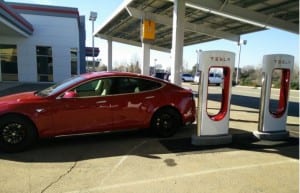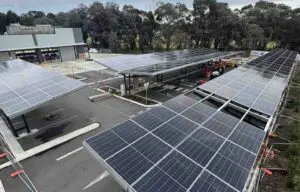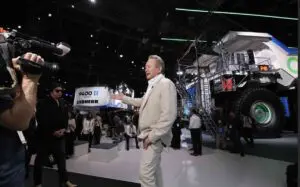The tension is building again as chronic innovator, visionary, world changer Elon Musk is leaning into the next iteration of sustainable transport. In a talk yesterday in Oslo, Norway, Elon spoke with the Prime Minister of Norway and touched on Tesla’s plans for what comes after Model 3, mass transit and urban mobility solutions, battery pricing, renewable energy … and, of course, the importance of putting a price on carbon emissions.
Elon Loves Norway
The discussion kicked off with Elon spreading some love on Norway. Norway has taken an aggressive approach to driving EV adoption in the country and, as such, has the highest concentration of EVs per capita of any country in the world.
Elon noted this and shared his vision for a sustainable economy which pairs sustainable electric power generation with sustainable, battery-electric vehicle transportation. Because of the work Norway has done to drive early EV adoption, it is already strategically positioned to pave the way for the rest of the world to a place run on completely sustainable transportation.
Supporting that migration, Norway has a surplus of hydropower generation resources due to the natural landscape of the country. Elon advocated making use of the natural hydroelectric resources of the country in a responsible way even advocating the use of micro turbines which can tap into hydro resources with a smaller impact on the natural landscape.
In summary: “I love Norway!” — Elon Musk
Tesla in Norway
Building on that theme, Elon shared that Tesla does its cold-weather engineering, testing, and validation in Norway and has made a large investment in charging infrastructure in Norway to the point where Tesla has invested more in Norway per capita than any other country outside the US. It’s clear that Tesla sees Norway as both a key market in the short term but also as a great model for other countries looking to transition to EVs to follow.
A Carbon Tax
As has been the approach for several of the last talks, Elon made a point of boldly using his platform to speak to the importance of taking action on climate change and CO2 and CO2e emissions (CO2e is “CO2 equivalent” gases — aka, other greenhouse gases). Putting a price on what are currently unpriced externalities that essentially amount to trillions of dollars in subsidies enjoyed by the petrol industry over the last hundred or so years is key to letting the market correct for these invisible risks.
With renewables like solar and wind already beating their hydrocarbon-based counterparts on price in many markets, putting a price on carbon and letting the market weed out the victor will only increase the speed at which we transition to renewable generation for our electricity. Flexing his cross-cultural fluency, Elon used the example of a petrol car speeding down the road and asked the audience to imagine a huge krone (Norwegian currency) sign on it because of the subsidies it is getting by being able to pollute for free. Polluting a resource owned and used by the citizens of the world must be taxed, as there are direct financial, health, climate, and security impacts to the gases currently being pumped into the atmosphere.
What’s Next for Tesla
Reiterating what Diarmuid O’Connell shared last week, Elon stated that there are “now almost 400,000 reservations for the Model 3” and even leaned into what Tesla is working on … or at least thinking about working on after Model 3. Specifically, mention was made of a 4th-generation vehicle and the promise of smaller cars that would be more affordable than the Model 3.
With Model 3 being affordable to ~50% of potential buyers, the fact that Tesla is looking at a compact or economy-sized vehicle post-Model 3, it’s clear that, while the Model 3 is a MAJOR accomplishment, it is not the crowning achievement for the company, simply the end of the first phase of the journey. Elon spoke very casually with the PM and, as at the Model 3 unveiling, Elon was in a very happy mood. It really feels like getting Model 3 out into the spotlight and, maybe more importantly, securing hundreds of thousands of reservations have taken a load of stress off his shoulders.
Urban Transportation Solutions
Having put the stress leading up to the Model 3 event behind him, Elon and team are back at the whiteboard, dreaming up next-generation solutions to either design and deploy in-house or to punt to the broader scientific and engineering community a la Hyperloop. As the discussion with Ketil Solvik-Olsen, the Norwegian Minister of Transport and Communications, shifted towards cities, the idea of Tesla building its own autonomous ride-sharing solution like Uber or Lyft once again reared its head. Here’s the dialog from that exciting piece of the discussion:
EM: We have an idea for something which is not exactly a bus but would solve the density problem for inner-city situations. I think we need to actually rethink the whole concept of public transport and create something that people are actually going to like a lot more. I don’t want to talk too much about it.
Moderator: Are you talking about the hyperloop?
EM: No, no. The hyperloop is great for going between cities … but … I have to be careful what I say. I very much agree with solving the high-density, over-transport problem. I think there’s a new type of car or vehicle that I think would be really great for that and actually would take people to their final destination and not just to the bus stop, which I think is great.
KS-O: So where do you see autonomous vehicles in this?
EM: Autonomous vehicles are key.

This builds on what Elon hinted at in a recently quarterly update and confirms that Tesla isn’t just building vehicles and battery packs but is looking much more comprehensively at transportation and toward building sustainable solutions for the entire spectrum. With Tesla being the second-largest EV producer in the world today, behind BYD, and plans to continue the crazy growth trend over the next few years, would Lyft and Uber stand a chance against a Tesla-backed autonomous ride-sharing service?
Granted, considering GM’s recent $500 million investment into Lyft and more recent $1 billion purchase of Cruise Automation, it’s clear that it won’t be a full court sweep by Tesla, but it’s not difficult to imagine Tesla moving into the market with a commanding lead in autonomous technology, battery pricing, and brand image all being rolled together to put the hurt on yet another set of incumbents in yet another market.
Batteries in the Future
Speaking to the challenges that batteries pose in the overall equation, Elon shared how the brightest minds in history have struggled to increase the capacity and density of batteries but are basically fighting against the laws of thermodynamics … even going so far as to say that improving battery technology is one of the most difficult problems we have been faced with.
The Tesla approach to cracking the nut of battery price equation is to centralize everything, bringing in loads of raw materials and having finished packs coming out as the products … in short, the Gigafactory. Centralizing everything maximizes economies of scale, while at the same time cutting out non-value-add transportation and warehousing, which, when talking about something as heavy as batteries and raw lithium, can add up quickly.
You can view the full talk, discussion, and Q&A with Elon … which is one of the best discussions in the last few months … here. There is a brief intro, with Elon coming on around minute 18. It’s worth noting that the video didn’t play for me in Chrome but worked fine in Safari and Firefox (c’mon, Google, what’s up with that?!).
Source: CleanTechnica. Reproduced with permission.










